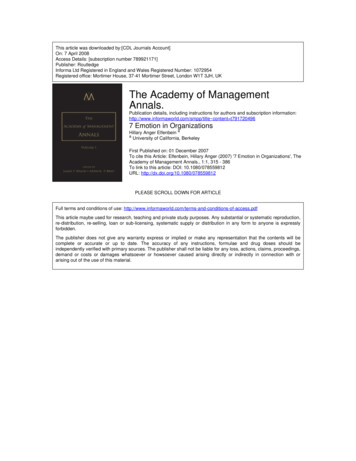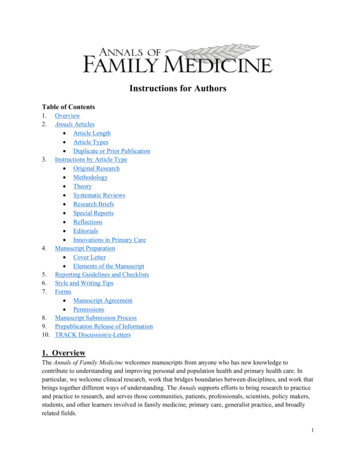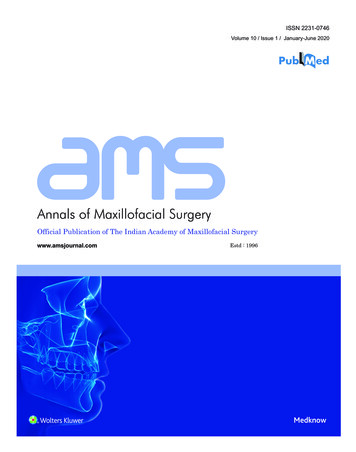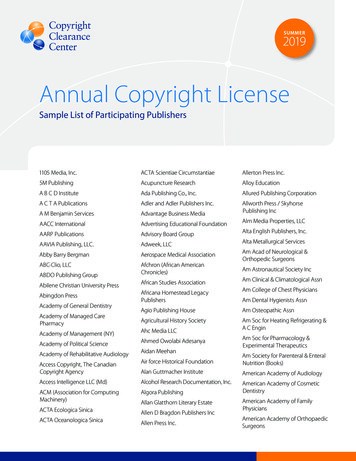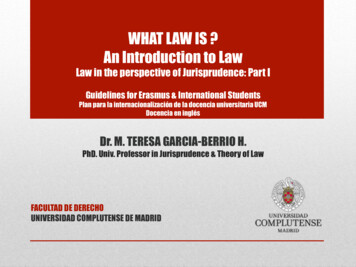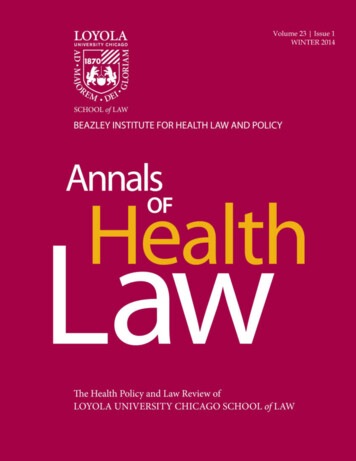
Transcription
A N N A LS O F H E A L T H L A WT H E H E A L T H PO L I C Y A ND L A W R E V I E W O FL O Y O L A U N I V E RSI T Y C H I C A G O S C H O O L O F L A WBEAZLEY INSTITUTE FOR HEALTH LAW AND POLICYEDITOR-IN-CHIEFJamie LevinPUBLICATIONS EDITORSerj MooradianTECHNICAL PRODUCTION EDITORDonna MillerADVANCE DIRECTIVE EDITORMeghan FunkSYMPOSIUM EDITORLoukas KalliantasisMARKETING & COORDINATING EDITORChristopher MacDonaldSENIOR PUBLICATIONS EDITORAlexander MikulaschekSPECIAL PROJECTS EDITORMichael MeyerADVANCE DIRECTIVE SENIOR EDITORMatthew NewmanANNALS SENIOR EDITORSLisa DannewitzSarah JinDeborah MoldoverMarcus MorrowMatt BrothersDaniel BurnsCarrie ClassickAnne Compton-BrownChristopher ConwayErica CribbsJarel CurveyArianne FreemanSheila GeraghtyColin GoodmanJena GradyTyler HansonRobert HoganAshley HuntingtonMary JohnstonCourtney KahleMelissa KongGreg LamorenaSpencer LickteigRebecca LiebingJean LiuKathleen MurphyGrant PeoplesRachelle SicoMEMBERSMiriam NeemsAndrea ReinoLeighanne RootMolly RyderAdrienne SaltzKelly Gallo StrongBenjamin VanGelderenMichael WeissKatie WithamAnnette WojciechowskiJessica WolfFACULTY ADVISORSLawrence E. Singer, J.D., M.H.S.A.Director and Professor of Law, Beazley Institute for Health Law and PolicyLoyola University Chicago School of LawJohn D. Blum, J.D., M.H.S.John J. Waldron Research Professor of Health LawLoyola University Chicago School of LawBUSINESS MANAGERKristin CorriganVOLUME 23, ISSUE 1WINTER 2014
!The Health Consequences of Sex Traffickingand Their Implications for Identifying Victimsin Healthcare FacilitiesLaura J. Lederer* and Christopher A. Wetzel**INTRODUCTION[W]hen I WXUQHG ,¶G KDG HQRXJK RI WKH DEXVH LQ KRPH DQG , UDQ DZD\ , GLGQ¶W NQRZ ZKHUH WR JR VR , ZHQW WR WKH FHQWHU RI WRZQ DQG VWRRG E\ the town hall. A man saw me hanging around there and he said that heZDV ORRNLQJ IRU D µSURWpJp ¶ , GLGQ¶W NQRZ ZKDW LW was but it sounded fineWR PH H VDLG WKDW , FRXOG VWD\ DW KLV KRXVH LI , GLGQ¶W KDYH D SODFH WR stay. . . . When we got to his house he pulled out a bottle of gin and hadme drink and drink. The next thing I remember is waking up drunk in hisbed all wet and hurt. He took me out on the street and told me what to do. . . During that time I saw 10 to 20 men a day. I did what he saidbecause he got violent when I sassed him. I took all kinds of drugs²HYHQ WKRXJK , GLGQ¶W UHDOO\ OLNH PRVW RI WKHP Over the years I hadpimps and customers who hit me, punched me, kicked me, beat me,slashed me with a razor. I had forced unprotected sex and got pregnantthree times and had two abortions at [a clinic]. Afterward, I was back outon the street again. I have so many scars all over my body and so manyinjuries and so many illnesses. I have hepatitis C and stomach and backpain and a lot of psychological issues. I tried to commit suicide severaltimes. Kayla, survivor1.D\OD¶V story is typical of women and girls trafficked for commercial sex!* President, Global Centurion; Subject Matter Expert, U.S. Department of Defense;Adjunct Professor of Law, Georgetown Law Center; Senior Advisor on Trafficking, Officeof Global Affairs, US Department of State, 2002 2009.** J.D. Candidate, University of Virginia, 2015; B.A., Grove City College, 2012.The authors would like to acknowledge the following for their support in the course of thisinvestigation: Abolition International; Charlotte Lozier Institute; The Giving Fund; TheGreenbaum Foundation; Gulton Foundation, Inc.; Vanguard Charitable EndowmentProgram; and an anonymous donor.1. All survivor names have been changed to protect their privacy."#!
Vol 23, 2014Annals of Health LawHEALTH CONSEQUENCES OF SEX TRAFFICKING62in the United States. Experiences like the ones she describes were reportedby trafficking survivors who answered questions about their traffickingexperience in a series of focus groups. Her story represents not the worstthat occurs in sex trafficking, but rather, the common experience of womenand girls trafficked into commercial sex by a criminal industry thatgenerates an estimated 33.9 billion per year worldwide.2This paper explores the health consequences and healthcare experiencesof women and girls trafficked in the United States for commercial sex. Thepaper is based on an original study of over one hundred domestic sextrafficking victims and survivors. It provides evidence that women andchildren who are trafficked into prostitution are physically, mentally, andemotionally devastated by the crime, and this devastation is lasting withinjuries, illnesses, and impairments continuing for decades. It illustrateshow our healthcare system is failing trafficked women and children. Itmakes the case that health care providers of all kinds in emergency wards,healthcare clinics, and private practices are seeing trafficking victims butfailing to identify them, thereby unwittingly contributing to continuingcriminal activity and exacerbating both public and private physical andmental health problems for this segment of the population. It offersrecommendations on ways that public policy and healthcare practice cancombat sex trafficking by more readily identifying victims and catalyzingrescues. Finally, it argues that law, policy, and protocols must change inorder to adequately address the health consequences of sex trafficking.Section I briefly summarizes previous studies on health and humantrafficking and puts the current study in context. Section II describes thecurrent study, including methodology used to collect information fromsurvivors. Section III presents the results of the study, detailing findings onVXUYLYRUV¶ SK\VLFDO DQG PHQWDO Kealth issues. In addition, it describesYLFWLPV¶ FRQWDFW ZLWK KHDOWKFDUH SURYLGHUV GXULQJ WKH WLPH WKH\ ZHUH trafficked. Section IV summarizes critical issues in the provision of healthcare for sex trafficking victims, with particular attention to reproductivehealth care. Finally, Section V sets forth recommendations for legislators,policymakers, and healthcare professionals.I.PREVIOUS LITERATURE AND CONTEXTThe current study fills a gap in the growing body of literature on healthand violence in the context of sex trafficking. A majority of trafficking!2. Patrick Belser, Forced Labor and Human Trafficking: Esti mating the Profits 14 (Int¶lLabour Office, Working Paper No. 42, 2005), available at ent.cgi?article 1016&context forcedlabor.
Vol 23, 2014Annals of Health LawHEALTH CONSEQUENCES OF SEX TRAFFICKING63related studies have focused on trafficking outside of the United States.These studies have often concentrated narrowly on one or two aspects ofsex trafficking, such as the prevalence of sexually transmitteddiseases/infections (STDs/STIs)3 or mental health issues,4 though a fewtook a more comprehensive approach to examining the health and violencerelated experiences of women in the commercial sex industry.5International studies established that trafficking victims are subject to amyriad of physical and psychological symptoms stemming from extensiveabuse.6Recently, some researchers have undertaken domestic studies on sextrafficking as well.7 Three early studies surveyed 100 or more women and!3. See, e.g., Audrey E. Pettifor et al., Increased Risk of Chla mydial and GonococcalInfection in Adolescent Sex Workers in Madagascar , 34 SEXUALLY TRANSMITTED DISEASES475 (2007); Jay G. Silverman et al., HIV Prevalence and Predictors Among Rescued SexTrafficked Women and Girls in Mumbai, India , 43 J. ACQUIRED IMMUNE DEFICIENCYSYNDROMES 588 (2006); Jay G. Silverman et al., Syphilis and Hepatitis B Co-InfectionAmong HIV-Infected, Sex-Trafficked Women and Girls, Nepal, 14 EMERGING INFECTIOUSDISEASES 932 (2008); see also Arun Kumar Acharya, Sexual Violence and Proximate Risks:A Study on Trafficked Women in Mexico City, 12 GENDER, TECHNOLOGY & DEVELOPMENT 77(2008).4. See, e.g., Geetha Suresh et al., An Assessment of the Mental Health of Street-BasedSex Workers in Chennai, India , 25 J. CONTEMP. CRIM. JUST. 186 (2009); Hyunjung Choi etal., Posttraumatic Stress Disorder (PT S D) and Disorders of Extreme Stress (D E S NO S)Symptoms Following Prostitution and Childhood Abuse , 15 VIOLENCE AGAINST WOMEN 933(2009); See, e.g., Mazeda Hossain et al., The Relationship of Trauma to Mental DisordersAmong Trafficked and Sexually Exploited Girls and Women , 100 AM. J. PUB. HEALTH 2442(2010);5. See, e.g., Melissa Farley et al., Prostitution and Trafficking in Nine Countries: AnUpdate on Violence and Posttraumatic Stress Disorder , 2 J. TRAUMA PRAC. 33 (2003); See,e.g., Cathy Zimmerman et al., The Health of Trafficked Women: A Survey of WomenEntering Posttrafficking Services in Europe , 98 AM. J. PUB. HEALTH 55 (2008).6.Olga Gajic-Veljanoski & Donna E. Stewart, Women Trafficked into Prostitution:Determinants, Human Rights, and Health Needs, 44 TRANSCULTURAL PSYCHIATRY 338, 35253 (2007).7.See, e.g., Celia Williamson & Michael Prior, Domestic Minor Sex Trafficking: ANetwork of Underground Players in the Midwest, 2 J. CHILD & ADOLESCENT TRAUMA 46(2009); KEVIN BALES & STEVEN LIZE, TRAFFICKING IN PERSONS IN THE UNITED STATES: AREPORT TO THE NATIONAL INSTITUTE OF JUSTICE 16-17 (2005), available 0.pdf.; Rochelle L. Rochelle L. Dalla, NightMoves: A Qualitative Investigation of Street-Level Sex Work, 26 PSYCHOL. WOMEN Q. 63(2002). These studies are qualitative in nature, communicating important narratives but notproviding quantitative data. Other literature focuses on experiences of violence and/orsubstance abuse among victims but does not provide substantial data on victims¶ physicaland mental health consequences. See, e.g., Steven P. Kurtz et al., Sex Work and ³ Date Violence, 10 VIOLENCE AGAINST WOMEN 357 (2004) [hereinafter Kurtz et al., Violence];Jody Raphael & Deborah L. Shapiro, Violence in Indoor and Outdoor Prostitution Venues,10 VIOLENCE AGAINST WOMEN 126 (2004) [hereinafter Raphael & Shapiro, Violence]; AmyM. Young et al., Prostitution, Drug Use, and Coping with Psychological Distress, 30 J.
Vol 23, 2014Annals of Health LawHEALTH CONSEQUENCES OF SEX TRAFFICKING64touched on the problems that the instant study examines, but were eachlimited to a single city and examined a comparatively small number ofhealth consequences.8 The most comprehensive early study interviewedvictims in five U.S. regions and discussed violence at length while touchingon both physical and mental health consequences.9 However, it was smalland somewhat narrow in focus.10While other studies have been conducted,11 two Minnesota-based studies!DRUG ISSUES 789 (2000); Nabila El-Bassel et al., Correlates of Partner Violence AmongFemale Street-Based Sex Workers: Substance Abuse, History of Childhood Abuse, and HIVRisks, 15 AIDS PATIENT CARE & STDS 41 (2001).8.See Roberto J. Valera et al., Violence and Post Traumatic Stress Disorder in aS a mple of Inner City Street Prostitutes, 16 AM. J. HEALTH STUD. 149, 149 (2000) (studyingviolence generally and PTSD, but not physical symptoms); Roberto J. Valera et al.,Perceived Health Needs of Inner-City Street Prostitutes: A Preliminary Study, 25 AM. J.HEALTH BEHAV. 50, 50 (2001) (discussing five types of violence, sixteen physicalsymptoms, PTSD, and substance use); JODY RAPHAEL & DEBORAH L. SHAPIRO, CTR. FORIMPACT RESEARCH, SISTERS SPEAK OUT: THE LIVES AND NEEDS OF PROSTITUTED WOMEN INCHICAGO 4 (2005) [hereinafter RAPHAEL & SHAPIRO, SISTERS], available peakout.pdf (interviewing 222 victims inChicago on 39 chronic physical health problems as well as experiences of violence andsubstance abuse, but not mental health).9. JANICE G. RAYMOND & DONNA M. HUGHES, COAL. AGAINST TRAFFICKING IN WOMEN,SEX TRAFFICKING OF WOMEN IN THE UNITED STATES 7 (2001), available athttp://action.web.ca/home/catw/attach/sex traff us.pdf.10. Id. at 29 (interviewing only ten participants).11. In 2004-2005, researchers published a series of Miami-based studies focusing ondrug use, social service needs and barriers to them, and the connections between an abusivepast, mental health problems, and HIV risk. See Hilary L. Surratt et al., Sex Work and DrugUse in a Subculture of Violence , 50 CRIME & DELINQUENCY 43, 46 (2004); Steven P. Kurtzet al., Barriers to Health and Social Services for Street-Based Sex Workers, 16 J. HEALTHCARE POOR & UNDERSERVED 345, 345 (2005) [hereinafter Kurtz et al., Barriers]; Hilary L.Surratt et al., The Connections of Mental Health Problems, Violent Life Experiences, and theMilieu of the ³Stroll with the HIV Risk Behaviors of Female Street Sex Workers, 17 J.PSYCHOL. & HUM. SEXUALITY 23, 23 (2005). These studies saw high rates of participationand asked respondents about their overall health condition but did not discuss specificphysical health symptoms and limited participation to victims who were current drug usersand still active in the commercial sex trade. See, e.g., Surratt et al., supra , at 46; Kurtz et al.,Barriers, supra , at 346. Another 2004 study made unique contributions to the literature,revealing disturbing mortality rates among women in prostitution in Colorado andconcluding that ³[w]omen engaged in prostitution face the most dangerous occupationalenvironment in the United States. John J. Potterat et al., Mortality in a Long-term OpenCohort of Prostitute Women, 159 AM. J. EPIDEMIOLOGY 778, 780-82, 784 (2004). The studyalso found that ³active prostitutes were almost eighteen times more likely to be murderedthan women of similar age and race during the study interval. Id. at 782. The study didnot, however, address specific physical and mental health symptoms. Another 2005 studyexamined the role of medical care providers, but interviewed only twenty-one victims inthree cities and was primarily qualitative. FAMILY VIOLENCE PROT. FUND, TURNING PAININTOPOWER:TRAFFICKING SURVIVORS¶ PERSPECTIVESONEARLY INTERVENTION STRATEGIES
Vol 23, 2014Annals of Health LawHEALTH CONSEQUENCES OF SEX TRAFFICKING65are especially relevant. A 2010 survey of 117 Minneapolis womenH[DPLQHG WKH LPSDFW RI YLFWLPV¶ DJH RI HQWU\ LQWR FRPPHUFLDO VH[ RQ substance abuse and HIV risk.12 Because of these emphases, however, itdiscussed physical and emotional health consequences only at a high levelof generality, such as whHWKHU SDUWLFLSDQWV ³HYHU KDG DQ 67' RU ³HYHU H[SHULHQFHG HPRWLRQDO YLROHQFH 13 Another 2011 study of 105 NativeAmerican women engaged in commercial sex in Minnesota14 covered asubstantial range of violent experiences, physical and health symptoms, anddrugs, as well as Post-Traumatic Stress Disorder (PTSD).15 The studycontains some discussion of other mental health symptoms, but primarily inthe context of determining whether the victims suffered from PTSD.These studies set the stage for our current, more expansive study, whichlooks at over 200 health issues in more detail and across a broadergeographic and ethnic spectrum. As far can be determined, our study is thefirst to examine many of the reproductive health issues experienced by sextrafficking victims, including birth control usage, pregnancies, miscarriages,and forced and elective abortions. In addition, it analyzes health care accessand interactions and collects data on symptoms experienced both duringand after trafficking.II. METHODSThis study collected data from female sex trafficking survivors.16 Thestudy used a mixed-methods approach, combining qualitative datacollection from focus groups and structured interviews with quantitativeanalysis. An initial feasibility study using a single focus group wasconducted in November of 2011. Following this initial focus group, a!(2005), available at 2. Lauren Martin et al., Meaningful Differences: Comparison of Adult Women WhoF irst Traded Sex as a Juvenile Versus as an Adult , 16 VIOLENCE AGAINST WOMEN 1252,1252 (2010).13. Id. at 1262.14. MELISSA FARLEY ET AL., PROSTITUTION RESEARCH & EDUC., GARDEN OF TRUTH:THE PROSTITUTION AND TRAFFICKING OF NATIVE WOMEN IN MINNESOTA, 22 (2011)[hereinafter FARLEY ET AL., PROSTITUTION RESEARCH], available at http://www.prostitutionresearch.com/pdfs/Garden of Truth Final Project WEB.pdf.15. Id. at 28-30, 35-40.16. The terms ³survivor and ³trafficking survivor will be used throughout to refer tothe individuals interviewed in this study. ³Victim and ³trafficking victim will refergenerally to individuals who are victims of trafficking as defined by the Trafficking VictimsProtection Act of 2000. 22 U.S.C.A. § 7102(15) (West, WestlawNext through P.L. 106386). The statute defines ³sex trafficking as ³the recruitment, harboring, transportation,provision, or obtaining of a person for the purpose of a commercial sex act. § 7102(10).
Vol 23, 2014Annals of Health LawHEALTH CONSEQUENCES OF SEX TRAFFICKING66series of eleven similar focus groups were conducted in cities across theUnited States from January 2012 to December 2012.17 Local leaders in theanti-trafficking movement, often survivor-led service providers, were askedto assist in locating survivors in their cities who wished to participate in thestudy. The focus groups included 107 participants, all domestic survivorsof sex trafficking, ranging in age from fourteen to sixty. During these focusgroups, participants commented on and discussed a range of topics,including subjects such as any early childhood trauma, the age at whichthey were trafficked, how they were recruited, how long they were held incaptivity, and the overarching health issues they experienced. Followingthe focus group sessions, survivors completed an extensive health survey.18The health survey included three components. In the first component,survivors reported on more than one hundred discrete health conditionsGUDZQ SULPDULO\ IURP WKH :RUOG HDOWK 2UJDQL]DWLRQ¶V 6WDWLVWLFDO Classification of Diseases and Related Health Problems. 19 These healthproblems ranged from neurological and gastrointestinal symptoms torespiratory, cardiovascular, and dermatological conditions. Survivorsanswered questions about conditions in categories including, general health,communicable and non-communicable diseases, dental health, substanceabuse, as well as nearly thirty psychological symptoms and disorders. Thefirst component also asked about a range of sexually transmitted infections,gynecological and urinary tract conditions, birth control usage, pregnancy,and pregnancy outcomes.Because of the ubiquity of violence in sex trafficking,20 the firstcomponent also sought information about violence that the traffickingvictim endured. The questionnaire asked whether the victim had been!17. The cities chosen included Columbus, Ohio; Honolulu, Hawaii; San Diego, SanFrancisco, and Sacramento, and Los Angeles, California; Minneapolis, Minnesota; St. Paul,Minnesota; St. Louis, Missouri; Washington, D.C.; Asheville, North Carolina; Nashville,Tennessee. The initial ³feasibility group was conducted in Washington, D.C. in Novemberof 2011, with a pilot study in Columbus, Ohio, shortly thereafter. The average focus groupsize was just under nine trafficking victims, with the largest group being twenty-twoparticipants (St. Louis), and the lowest being two participants (Los Angeles). Theparticipants came from survivor centered service providers and shelters including, but notlimited to, Courtney¶s House; Breaking Free; Kwanzaa Northside Women¶s Space; PacificAlliance to Stop Slavery; Save Our Adolescents from Prostitution (SOAP); Courage House;Magdalene; Generate Hope; Veronica¶s Voice; and On Eagles Wings.18. See infra , Appendix for a sample questionnaire completed by a survivor.19. See generally WORLD HEALTH ORG., INTERNATIONAL CLASSIFICATION OF DISEASES(2010), available at http://www.who.int/classifications/icd/en/.20. See, e.g., RAYMOND & HUGHES, supra note 9, at 63-65, 67-68, 75-77; Raphael &Shapiro, Violence, supra note 7, at 132-36; Kurtz et al., Violence, supra note 7, at 367-78;RAPHAEL & SHAPIRO, SISTERS, supra note 8, at 18-20.
Vol 23, 2014Annals of Health LawHEALTH CONSEQUENCES OF SEX TRAFFICKING67subjected to physical abuse, such as being beaten, punched, kicked, raped,penetrated with foreign objects, threatened with a weapon, burned withcigarettes, strangled, stabbed, slashed, or forced to have unprotected sex. Inaddition to physical violence, victims indicated whether they were violatedin other ways, such as being asked to participate in pornography, recreate ascene from pornographic material, or submit to abuse by a person inauthority.The second component of the survey consisted of a series of open-endedquestions about health care. It asked such questions as whether and howlong the victim used birth control during the time she was trafficked, wherethe birth control was obtained, who escorted the victim to the facility wherebirth control was obtained, and the type of birth control used. Becauseprevious studies have identified health care providers as critical potentialidentifiers of trafficking victims,21 the second component also asked whattypes of facilities survivors had visited to receive medical treatment andwhether the healthcare provider asked or knew about their situations. Eachvictim also answered more detailed reproductive health questions, includingher history of pregnancies, miscarriages, abortions and live births, wherethe abortions and/or births occurred, and whether she maintained custody ofany children she had. With respect to abortion, the victim indicated howmany abortions she had undergone, at what stage of pregnancy, andwhether the abortion was coerced.The final component of the questionnaire asked victims about thesymptoms they experienced after escaping trafficking. This componentcovered the same range of physical and psychological symptoms as the firstcomponent. A full copy of a completed questionnaire is included in thisDUWLFOH¶V SSHQGL[ Answers from the questionnaires were coded and entered in aspreadsheet. For questions in the first and third components wheresurvivors circled symptoms to indicate that they had experienced them, abinary coding system (1 if circled, 0 if not) was used. For the open-endedsecond component, common answers were assigned a number and forquestions where survivors gave an unwieldy variety of answers, the leastFRPPRQ DQVZHUV ZHUH JURXSHG LQWR D VLQJOH ³RWKHU FDWHJRU\ 22 When!21. See, e.g., Helen Cole, Human Trafficking: Implications for the Role of the AdvancedPractice Forensic Nurse, 14 J. AM. PSYCHIATRIC NURSES ASS¶N 463, 466 (2009) (citingJeffrey Barrows & Reginald Finger, Human Trafficking and the Healthcare Professional ,101 S. MED. J. 521 (2008)); ERIN WILLIAMSON ET AL., DEP¶T HEALTH & HUMAN SERVS.,NATIONAL SYMPOSIUM ON THE HEALTH NEEDS OF HUMAN TRAFFICKING VICTIMS: POSTSYMPOSIUM BRIEF 4-8 (2008).22. Coded data came almost exclusively from the questionnaires. Survivors¶ focus
Vol 23, 2014Annals of Health LawHEALTH CONSEQUENCES OF SEX TRAFFICKING68VXUYLYRUV GLG QRW DQVZHU D TXHVWLRQ WKH UHVSRQVH ZDV FRGHG DV ³1 This coding system allowed the spreadsheet program to count how manysurvivors gave each response by counting how many cells in a column werefilled with a given number. The totals were then calculated as percentagesboth of all survivors and of those who answered the particular question.The results section analyzes the frequency with which individual symptomsand experiences were reported by the survivors in this study as well as thepercentages of victims who reported at least one symptom or experience ina given category.III. RESULTSA. Physical Health SymptomsI am telling you that you have to not be in your sober mind to run thesetricks²\RX MXVW FDQ¶W GR LW VWUDLJKW VR HYHU\RQH RQ WKH VWUHHW LV KRRNHG RQ VRPH GUXJ ,¶YH GRQH GUXJV VR ORQJ , KDYH UHDOO\ KXUW P\ ERG\ , KDYH kidney disease, liver problems, hepatitis C, high blood pressure,polymyositis [an inflammatory muscular disease], and fibroid tumors. Taylor, survivorSurvivors suffered tremendously, virtually without exception. Out of106 survivors,23 105 (99.1%) reported at least one physical health problemduring trafficking. The most frequently reported physical problems wereneurological²91.5% of respondents24 reported at least one neurologicalsymptom and 82.1% specifically reporting memory problems, insomnia, orpoor concentration. Headaches or migraines (53.8%) and dizziness (34.0%)were also common symptoms. The trafficking experience ravaged thegeneral health of victims as well, with 85.7% reporting at least onesymptom in the general health category. In parWLFXODU WKH UHVSRQGHQWV¶ dietary health was often poor. Severe weight loss (42.9%), malnutrition(35.2%), loss of appetite (46.7%), and eating disorders (36.2%) wereespecially common; 71.4% of respondents reporting at least one of thesediet-related symptoms.The toll of constant commercial sexual exploitation and physical abuseon the victims led to a range of additional conditions. Physical injuries!group statements were consulted only in the few instances where a questionnaire answer wasunambiguous and the survivor¶s statements clarified it.23. One participant did not fill out the first component of the survey.24. Because many interviewees did not answer every question, percentages given are ofrespondents who answered the particular question, not necessarily of all 107 interviewees.
Vol 23, 2014Annals of Health LawHEALTH CONSEQUENCES OF SEX TRAFFICKING69were rampant, with nearly 70% of victims reported physical injuries, mostcommonly to the head or face. Symptoms not conventionally associatedwith sexual abuse were only slightly less common: 67.9% of respondentsexperienced some type of cardiovascular or respiratory difficulty and 61.3%suffered from gastrointestinal symptoms while being trafficked. More thanhalf of the survivors (54.3%) reported dental problems, with tooth loss themost common problem (42.9%). The only major health category in whichless than half of respondents reported a symptom was dermatologicalissues, which were nonetheless reported by 27.4% of respondents. ThisVWXG\¶V ILQGLQJV RI ZLGHVSUHDG SK\VLFDO KHDOWK FRQVHTXHQFHV DUH JHQHUDOO\ consistent with the results of previous domestic studies and build on theirfindings by revealing a more comprehensive picture of the health issues thatplague trafficking victims.25Table 1. Physical Health ProblemsC ategory% of respondents reporting atleast one symptom26Any Physical Health Problem99.1% (N 106)Neurological91.7% (N 106)General Health86.0% (N 105)Injuries69.2% (N 102)Cardiovascular/Respiratory68.5% (N 106)Gastrointestinal62.0% (N 106)Dental54.3% (N 105)B. Psychological Symptoms³7KH PHQWDO KHDOWK SUREOHPV DUH WKH ZRUVW DQG PRVW ORQJ ODVWLQJ , ZDV diagnosed with chronic depression, have anxiety, post-traumatic stressV\QGURPH QLJKWPDUHV IODVKEDFNV GLVRULHQWDWLRQ ,¶YH EHHQ VXLFLGDO DW !25. See, e.g., FARLEY ET AL, PROSTITUTION RESEARCH, supra note 14, at 29-30, 31;RAYMOND & HUGHES, supra note 9, at 79.26. The small differences in the number of respondents are due to some subjects electingto fill out some portions of the questionnaire but not others. Judgment occasionally had to beexercised by coders as to whether a given victim had not answered a section or had indicatednot experiencing any of the symptoms. However, such judgment was required on only asmall minority of surveys and was made with a presumption against selective completion ofthe questionnaire.
Vol 23, 2014Annals of Health LawHEALTH CONSEQUENCES OF SEX TRAFFICKING70WLPHV , GRQ¶W WKLQN DQ\RQH LV RXW RQ Whe street without having these longODVWLQJ HIIHFWV ²Amanda, survivorSurvivors were overwhelmingly traumatized not only physically, but alsomentally. The brutal treatment they endured created ongoing psychologicaland mental conditions in many of these victims and exploited existingmental instability in others. All but two of those who responded to thesurvey (104/106, 98.1%) reported at least one psychological issue duringtheir captivity and survivors noted an average of more than a dozen (12.11).The most frequently reported problems included depression (88.7%),anxiety (76.4%), nightmares (73.6%), flashbacks (68.0%), low self-esteem(81.1%), and feelings of shame or guilt (82.1%). The picture painted bythese surveys and the personal interviews that accompanied many of themis one of complete mental devastation. A substantial number of survivorssuffered from other psychological disorders, including acute stress (38.7%),bipolar (30.2%), depersonalization (19.8%), multiple personality (13.2%),and borderline personality (13.2%) disorders.Two additional and particularly chilling reporting rates confirm theextent of mental trauma that survivors suffered: 41.5% had attemptedsuicide (one victim reported 9 such attempts) and 54.7% suffered from PostTraumatic Stress Disorder. The psychological consequences that thetrafficking victims in these focus groups reported were wide-ranging,severe, and in some cases nearly universal. As with physical symptoms, thefindings on the psychological consequences of trafficking are consistentwith other studies.27Even the escape from their trafficking circumstances was far from aremedy for the psychological suffering of survivors. When reporting ontheir health experiences after trafficking, 96.4% of survivors reported atleast one psychological symptom and an average of 10.5. As the tablebelow indicates, there were only minor improvements in the number ofpsychological problems experienced when the victims escaped from theirtrafficking situations. Sex trafficking took a lasting mental and emotionalas well as physical toll on nearly every survivor in the study.!27. See, e.g., FARLEY ET AL., PROSTITUTION RESEARCH, supra note 14, at 31; RAYMOND& HUGHES, supra note 9, at 83; Melissa Farley & Howard Barkan, Prostitution, Violence,and Posttraumatic Stress
annals of health law the health policy and law review of loyola university chicago school of law beazley institute for health law and policy editor-in-chief jamie levin publications editor serj mooradian advance directive editor meghan funk marketing & coordinating editor christopher macdonald senior publications editor alexander mikulaschek technical production editor
